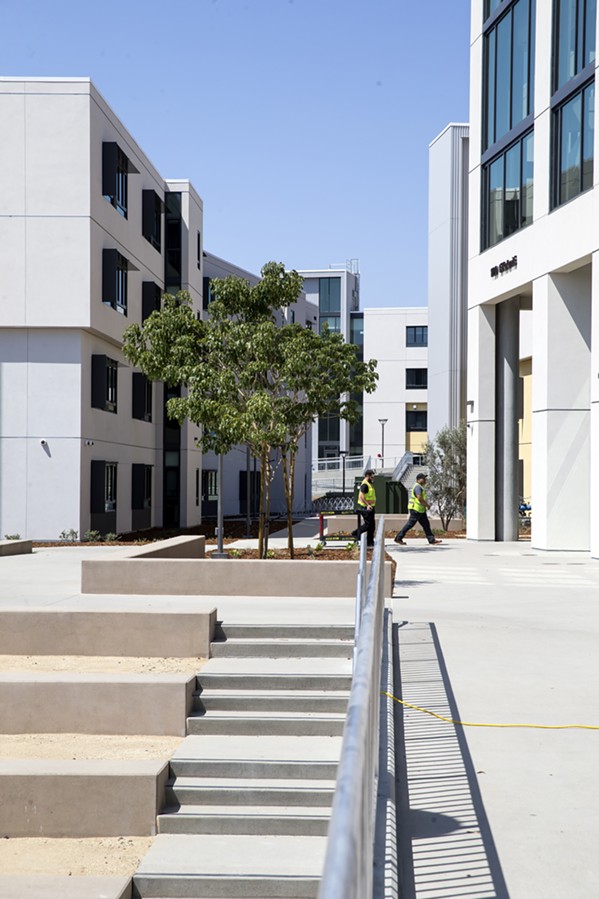New community, unbroken culture
Cal Poly's new residential community is helping solve the housing crisis while giving visibility to indigenous people
By Ashley Ladin[{
"name": "Ad - Medium Rectangle CC01 - 300x250",
"id": "AdMediumRectangleCC01300x250",
"class": "inlineCenter",
"insertPoint": "8",
"component": "2963441",
"requiredCountToDisplay": "12"
},{
"name": "Ad - Medium Rectangle LC01 - 300x250",
"id": "AdMediumRectangleCC01300x250",
"class": "inlineCenter",
"insertPoint": "18",
"component": "2963441",
"requiredCountToDisplay": "22"
},{
"name": "Ad - Medium Rectangle LC09 - 300x250",
"id": "AdMediumRectangleLC09300x250",
"class": "inlineCenter",
"insertPoint": "28",
"component": "3252660",
"requiredCountToDisplay": "32"
}]
A glottal stop is a consonant made by closing the flow of air to the throat; its symbol, "ʔ," mimics the curvature of a question mark. It may not be familiar to many Cal Poly students, but it is helping solve a familiar problem: the campus housing shortage. A new residential community, yakitutu, is bringing 1,450 more beds to campus, along with the glottal stop, subscript letters, and a different culture.
The newly constructed residential community is opening Fall 2018 on Cal Poly's campus and will house nearly 1,500 incoming freshmen students. The space is long overdue, and the need was especially apparent over the last two academic years. From the Fremont Hall mudslide-induced closure, to an incoming freshman class with 1,000-plus more students than expected, on-campus housing has been strained.
Cal Poly's solution does largely solve the problem—all first-year students will be back in residential halls and out of overflow on-campus apartments—but it also attempts to go beyond that. The new community was named to honor and in collaboration with the Northern Chumash tribe of yak titʸu titʸu yak tihini (ytt), the Indigenous Peoples of San Luis Obispo County.
The ytt were the first people in the San Luis Obispo region and still hold a presence here today. Their population declined with the arrival of the Europeans, the Spanish mission system, Mexican conquest, and American colonization. However, the Northern Chumash people continue to persist and are in the process of revitalizing their culture.
Cal Poly has received some backlash for the partnership, with concerns about exploiting the Northern Chumash culture. This was also an issue for the ytt tribe when Cal Poly first approached them regarding the idea. Project lead and ytt member, Leah Mata, stated she was originally wary of the project, but is pleased with the result.
"Marginalized communities need to keep [exploitation] in consideration. You don't want to commodify culture," Mata said. "But we had complete control over every aspect; [Cal Poly was] really careful about allowing our voice to come through. We pretty much completely dictated what the project looks like in tone, graphics, and cultural information."
The seven buildings that make up the yakitutu community are each named after a village or place in the San Luis Obispo region, and are laid out in a geographically correct order. For example, one building is named elewexe, which means "named for swordfish." This is how the ytt people refer to the modern location of Paso Robles.
"Our language describes our homeland instead of naming it after people. This allows for a better connection—it tells what the land's purpose is and our relationship to it," Mata said. "In Western culture locations tend to be named after people and not the space itself."
The university started introducing the building names to the campus community last academic year. University Housing produced pronunciation guides for each building, and members of ytt documented stories for each village. University spokesperson Matt Lazier said that Cal Poly is encouraging students to grow comfortable with the names.
"Saying the words takes a little practice, repetition, and a willingness to learn. But we're a college campus, and people come here because they want to learn," Lazier said in an email. "We're focusing on giving them resources to do that."
The university is asking students to say the full name of each building and avoid referring to the buildings by shortened names or acronyms. Mata also believes students should use the full names, but said she is open to students shortening the names in the future.
"I hope students learn and use the whole names to start. It will help them understand pieces of the language and our culture," Mata said. "But in American culture and pop and youth culture, shortening happens. If that happens organically, it's them taking ownership of those buildings within their own culture. Even we shorten the names."
Lazier wrote that the university's partnership with the ytt goes beyond just naming residential buildings, and educational programs are planned for the upcoming year. The partnership is designed to bring awareness to the indigenous people of San Luis Obispo and to allow students to learn about their language and culture. Mata hopes that giving the ytt culture a role on campus will help increase the visibility of indigenous people.
"A lot of times people in California don't see spaces as being indigenous occupied places. We want to get people to understand spaces in a way we do and share knowledge of those places with the larger community," Mata said. "It's important for people to understand we are still here and have a connection to the homeland." Δ
Editorial intern Ashley Ladin can be reached through New Times Editor Camillia Lanham at [email protected].








